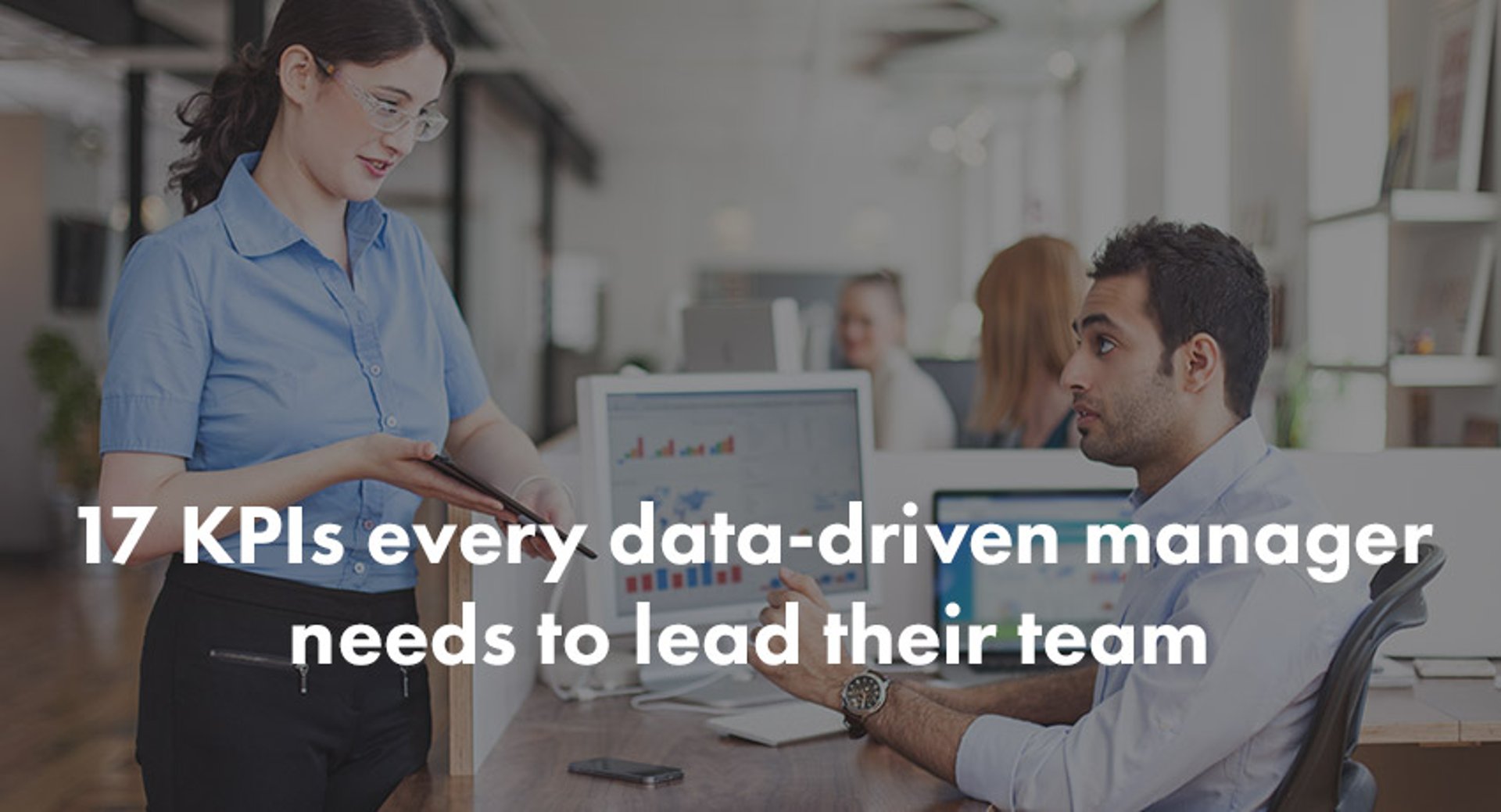The Ultimate Guide To Perfecting Your SaaS KPIs and Metrics

Published 2023-09-11
Summary - Like most data-driven minds, you’re on the lookout for more knowledge. Why? Because in the fast-paced world of SaaS, you fight a continuous battle between fueling the fire and letting your business take off by itself. Learn how to find that balance with SaaS KPIs and metrics.
Grab your coffee and get excited - you’ve stumbled upon our super-long article on everything SaaS KPIs, created especially for you! It clocks in around 4600 words - so you’ll probably want to come back to it a few times (that’s what bookmarking is for, right?).
What we’ve done in this article is created bite-sized introductions with step-by-step tutorials and examples. We’ve listed each SaaS topic in our “Table of Contents” in case you want to skip forward to a certain segment.
Table of Contents
Here’s a taste of what you’re going to learn over the next few thousand words:
- An Introduction to KPIs
- How to Decide Your Organization’s KPIs
- Best Practices for Picking the Right KPIs
- The Fundamental Metrics for a SaaS Business
- SaaS KPIs to Focus on at Each Stage of Growth
- Why KPIs Fail and Common KPI Mistakes
- Monitor Your KPIs with Dashboards and Reports
We will also provide you with additional resources that you can access if you wish to explore any of the subjects deeper. Ultimately, this blog will assist you in becoming more confident in driving and reaching your business objectives... no matter how big or small.
Trust us, this is going to be a fun read!

An Introduction to KPIs
Like most data-driven minds, you’re on the lookout for more knowledge. Why? Because in the fast-paced world of SaaS, you fight a continuous battle between fueling the fire and letting your business take off by itself. You know that hard work, creative thinking, and tenacity will help keep your team on top. So here you are, trying to find that balance.
Decision-Making Starts With Data
As mentioned, the world of SaaS is fast. This can cause uncertainty in many aspects of your business. For example, when your product or service components are constantly being upgraded or refurbished, your company is growing, or your role gets even busier than it already is. But this is what makes SaaS so special and what makes data extremely valuable to you.
What this means is that its power should be used to make data-driven business decisions, a smarter quantitative approach to decision-making, instead of relying strictly on your gut feel.
The bottom line is if you and your team are striving towards gaining a competitive edge over your competitors, or staying on top in an ever-changing field, the more consideration of your data when making decisions, the better.
What is a KPI?
The KPI definition is a measurable value that demonstrates how a company is performing. Organizations use KPIs at multiple levels to evaluate their success in reaching business objectives. High-level KPIs may focus on the overall performance of the enterprise, while low-level KPIs may focus on processes in departments such as sales, marketing, finance, or call centers.
Types of KPIs
Depending on the specific department you are developing KPIs for, there are a number of types your company should consider monitoring, as each department will want to measure success based on goals and targets specific to their line of work.
What makes a KPI effective?
A KPI is only as valuable as the action it inspires. Too often, organizations blindly adopt industry-recognized KPIs and then wonder why that KPI doesn't reflect their own business and fails to affect any positive change. One of the most important but often overlooked aspects of KPIs is that they are a form of communication. As such, they abide by the same rules and best practices as any other form of communication. Succinct, clear, and relevant information is much more likely to be absorbed and acted upon.
In terms of developing a strategy for formulating KPIs, your team should start with the basics and understand what your organizational objectives are, how you plan on achieving them, and who can act on this information. This should be an iterative process that involves feedback from analysts, department heads, and managers. As this fact-finding mission unfolds, you will gain a better understanding of which business processes need to be measured with KPIs and with whom that information should be shared.
Being SMART about your KPIs
One way to evaluate the relevance of a KPI is to use the SMART criteria. The letters are typically taken to stand for specific, measurable, attainable, relevant, and time-bound.
In other words:
- Is your objective specific?
- Can you measure progress toward that goal?
- Is the goal realistically attainable?
- How relevant is the goal to your organization?
- What is the time frame for achieving this goal?
SMART Examples:
A customer success team member could have a SMART KPI of 20 onboarding calls per quarter or $2000 new MRR per month.
A front-end developer could have a SMART KPI of contributing at least five improvements to the design system backlog or fixing at least five front-end bugs.
A digital marketer could have a SMART KPI of 90 referral trials per quarter or five new guest blogs per quarter.
“Not everything that can be counted counts, and not everything that counts can be counted.” - Albert Einstein.
This is the part in the blog that would be a great time to pour yourself another cup of joe. When you come back, you will learn how to narrow down what’s most important when defining your KPIs.
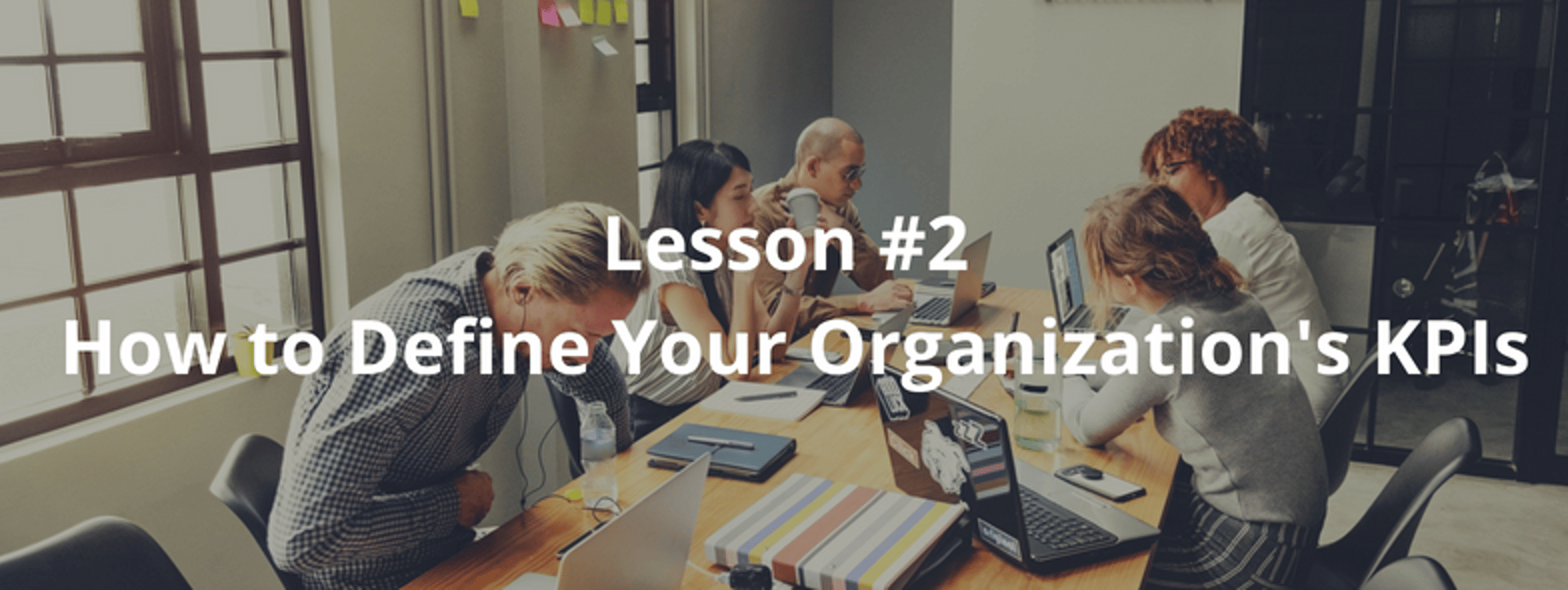
How To Define Your Organization’s KPIs
Understanding what a KPI is? Check.
Effectiveness of KPIs? Check.
Being SMART about KPIs? Check.
Now that you’ve had a brief introduction to the world of KPIs, how do you go about defining KPIs specific to your business objectives as a SaaS company?
Wait a second…
Before we break it down for you, we thought it’d be kind of fun to look at four analytics experts’ number one strategies to define their own KPIs.
“Number 1 way to getting actionable KPIs is starting with the end objective in mind and backing out what metrics accomplish this from there...” - Adam Singer, Google.
“Less is more – you really only want a few KPIs as the more you have, the harder it becomes to know what you should pay attention to and what’s just noise…” - Alex Clemmons, Cardinal Path.
“In summary: dig deep, dig deeper, then filter it to find what will make each team most successful…” - Anna Lewis, Polka Dot Data.
“Before getting to KPIs, you need to back all the way up to the ‘why’ for your business and determine what the most important questions are that you need to answer…” - Caleb Whitmore, Analytics Pros.
How to define your KPIs
SaaS leaders often feel the pressure to measure everything—that is, measure both the true startup metrics they've relied on in the past (daily active users and net revenue retention, for example) and the key SaaS growth metrics (like monthly MRR growth and churn rate) that will help catapult their growth.
This constant piling on more and more measurables can be overwhelming. Additionally, many SaaS leaders take the natural next step of jumping too far ahead—measuring efficiency metrics such as Gross Margin and CLV:CAC rather than remaining focused on growth. If you aren’t familiar with these metrics, don’t worry, we’ll cover those in Lesson 4.
The advice here is to focus on the KPIs that will get you to where you want to be rather than on those that keep you where you presently are.
Step 1: Determine your organization’s most important objectives.
Step 2: Choose KPIs that are fixed and capable of forecasting.
Let us explain further.
Breaking it down: fixed and forecasted
Here at Klipfolio, we’ve been thinking about KPIs for over a decade. After many iterations, here’s the simple definition we’ve come to find most valuable:
A key performance indicator is a measurable value that demonstrates how effectively a company is achieving key business objectives.
To us, a KPI must remain fixed and must be able to be forecasted. Let’s break each of those down:
Finding fixed
When we say fixed, we mean there’s continuity and reliability among the measured outcomes. In other words, an outcome at one point in time can reliably be compared to an outcome at another time.
For example, if in January and February, you found that 1 out of every 100 people who started a trial of your product became a customer, this would be a fixed statistic from which you might want to build a key performance indicator.
Finding what can be forecasted
There’s no need to go full-on artificial intelligence here, but KPIs must, at some level, help you forecast a result.
Let’s say it seems the time between trial-to-customer becomes significantly shorter when you reach a certain Net Promoter Score. This correlation may allow you to forecast: increased customer success = decreased time between trial-to-customer. Depending on what organizational objectives you’ve decided on, building a KPI around this forecast may be worth your time.
Measuring and monitoring business performance is critical, but focusing on the wrong metrics can be detrimental. Take a look at some of the best practices for picking the right KPIs for your business.
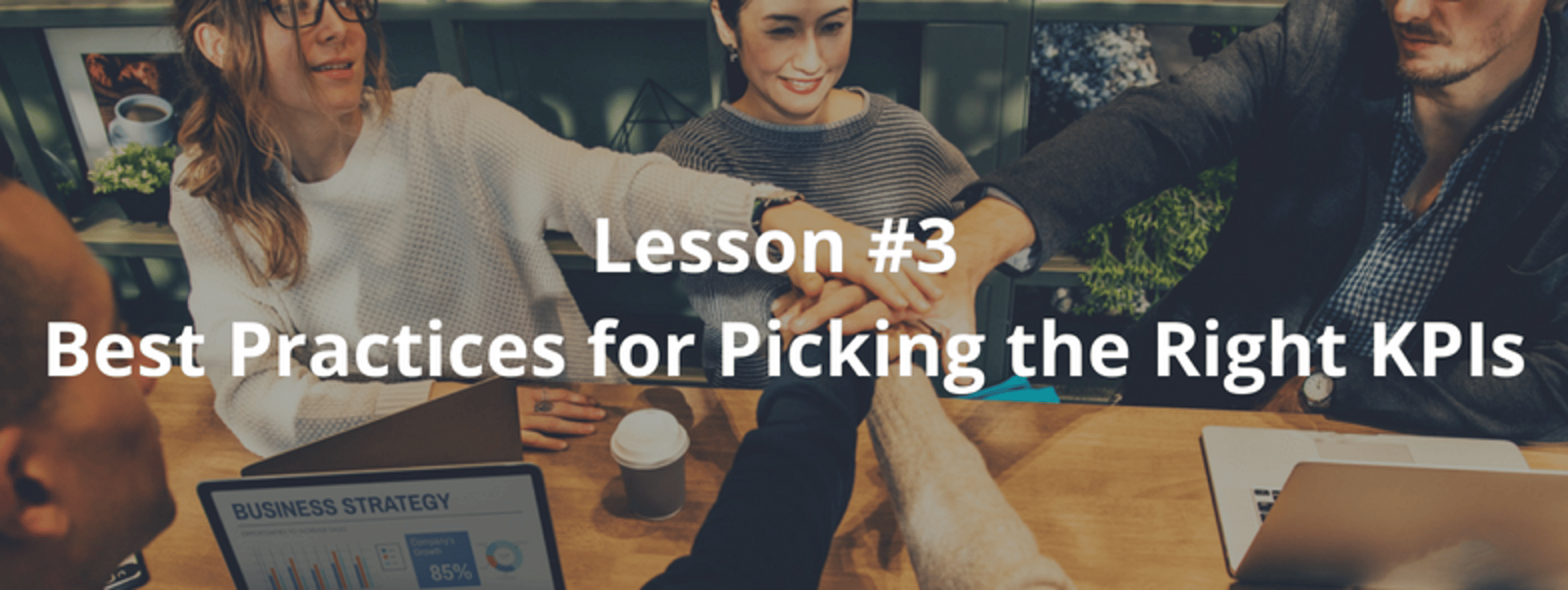
Best Practices For Picking The Right KPIs For Your SaaS Company
Data and metrics are everywhere. Measuring and monitoring business performance is critical, but focusing on the wrong metrics can be detrimental (as time and money are spent measuring, monitoring, and trying to optimize metrics that don’t matter much). The same can be said about poorly structured KPIs and KPIs that are too difficult and costly to monitor on a regular basis.
So what makes business performance indicators “key,” and how should a SaaS leader, executive, or manager select them?
Here are six strategies to help you separate effective, value-creating KPIs from detrimental, value-diminishing KPIs:
1. Pick KPIs that are aligned with your strategic business objectives
We touched on this in the last two lessons. KPIs must be aligned with the strategic goals and objectives of your company. Business “performance” is relative and ultimately measured against an organization’s mission and goals. KPIs must be grounded by these goals.
Good objectives: Reducing complaints by 50 percent over one year or improving resolution times to customer complaints to a minimum of one business day.
Bad objectives: Quadruple revenue in one month or have coffee with my employees once a week.
2. Make sure the KPIs you choose are attainable
There’s no point selecting a KPI for your company if the data behind the KPI can’t be obtained and presented to stakeholders or if doing so would be overly costly. In assessing the cost/benefit of selecting a particular KPI, ask yourself the following "What data points do I need to measure this KPI?" and "What technologies and processes do I need to implement to access this data on a regular basis?".
3. Be acute in your choice of KPIs
KPIs should keep everyone on the same page and moving in the same direction and should be specific enough to inform distinct actions. If a KPI is too high-level or too vague, it can be interpreted in many different ways, which means it can also be actioned in many different ways - which is not what you want.
4. Pick accurate KPIs
Another important consideration in selecting KPIs for your business is the accuracy of the data flowing into the KPI and the reliability of the KPI in predicting business performance. Ask yourself the following, "Does the KPI include all relevant information?" and "How accurate is the KPI in reflecting and predicting business performance?"
5. Select KPIs that are actionable
One of the most important considerations that should inform your selection of a business KPI is whether or not the KPI is actionable. Consider a double litmus test: can (at least some) of the events grounding the KPI be controlled by the business? If the circumstances fuelling the KPI are all out of your company’s control, then the KPI can’t be actioned. Second, is the KPI structured and presented in such a way to the right people to incite action?
6. Pick KPIs that are alive
It’s easy to get comfortable with a group of KPIs that you’ve depended upon for an extended period of time, but the high-tech world isn’t static, and your KPIs shouldn’t be either. Take the time to review your reasons for selecting specific KPIs periodically. Do these reasons still hold true? Has your business or the context within which it operates changed? Can your KPIs be refined to suit these changes?
Data, metrics, and “KPIs” are everywhere, and it's not hard to be disoriented and lose focus on the metrics that are truly mission-critical to your business. Within this context, taking the time to think critically about how and why a particular KPI is “key” to your business is more important than ever.
KPI Planner
Put what you’ve learned so far to work and dive into constructing your own KPIs with our helpful and simple KPI Planner! Next, we will start diving into a list of the key SaaS metrics every tech leader should be tracking.

The Fundamental Metrics for a SaaS Business
The SaaS model is relatively new, so it’s understandable that it’s not always easy to grasp how it works. We’re not like a clothing store that sells you a pair of jeans and then may never see you again; we’re more like a newspaper or magazine that sells you a renewable subscription. We want to retain customers and grow our base. Our fundamental metrics explain how we keep track of how we’re doing.
We’re using “we” here because Klipfolio is also a SaaS business. If you’re still in the growth stage, we’ve likely faced similar obstacles. Here are 5 of the metrics that we use at Klipfolio:
- Number of accounts
- Recurring revenue
- Recurring revenue growth rate
- The churn rate for both the number of accounts and recurring revenue
- Net recurring revenue retention
The first two metrics are the number of accounts and recurring revenue. Together, these growth figures tell us how many customers we have and how much they pay us on a recurring basis.
These two bits of information are the fundamental building blocks necessary to understand how a growth-oriented company (like ours) is performing. These metrics might be simple, but you should know these numbers in your sleep!
1. Number of Accounts
The number of accounts is straightforward: It’s the number of customers you have. This is calculated by:
Number of accounts = the sum of existing accounts and accounts gained, minus cancellations
2. Recurring Revenue
Recurring revenue is the money generated on a regular basis by the customers who have signed up for your service. It’s usually reported as either monthly recurring revenue (MRR) or annual recurring revenue (ARR).
There are only four things that can happen to your recurring revenue: (1) you get new MRR from brand new accounts; (2) existing accounts upgrade and pay you more MRR; (3) they downgrade and pay you less; or (4) they cancel altogether.
Recurring revenue = new + upgrades - downgrades - cancellations
Both of these basic building blocks - accounts and recurring revenue - can be looked at over time (for example, we added 10 new accounts today but lost 2 for a total increase of 8), or in their totality, as in ‘we have a total of 5,000 accounts as of today”.
Now that these two basic values are confirmed, we can move on to understanding how the business is growing.
We’ve identified three metrics that are crucial to understanding what’s happening with our accounts and recurring revenue:
- Recurring revenue growth rate
- The churn rate for both the number of accounts and recurring revenue
- Net recurring revenue retention
3. Recurring Revenue (RR) Growth Rate
The recurring revenue growth rate measures velocity. This tells us how quickly we are growing and what kind of a growth curve we’re on.
Month-over-month RR growth rate = (net RR added in period) / (total RR beginning of period)
The bigger you get, the harder it is to grow (doubling $50K MRR is very different from doubling $500K MRR). It is said that a company’s recurring revenue growth rate should go like this over its first five years of operation: Triple, triple, triple; double, double. (Sounds like an order at Tim Hortons… pardon the Canadian joke).
4. Churn Rate
The churn rate is the rate at which you lose customers. A subscription service can lose customers very easily, and it can be bad news if you lose even a small number of customers regularly. This is one of those metrics that will catch up with you as your base grows and can, in the worst of cases, mean that you’re losing more customers than you are able to win. The churn rate should be calculated both for accounts and for recurring revenue.
Account churn rate = (number of canceled accounts in period) / (total accounts beginning of period)
RR churn rate = (value of canceled RR in period) / (total RR beginning of period)
5. Net Recurring Revenue Retention
Net recurring revenue retention is a way to measure whether your base revenue is growing. Again, we measure it over a time period – a month or a year – and it is the total change in recurring revenue from your existing customers with upgrades, downgrades, and cancellations factored in. The best-in-class companies have a model where upgrades from existing customers outpace downgrades and cancellations. Do that, and growth will be much easier.
Net revenue retention = (RR beginning of period + upgrades - downgrades - cancellations) / (RR beginning of period)
Looking for more? In this next segment, we break down SaaS metrics even further using growth stages.
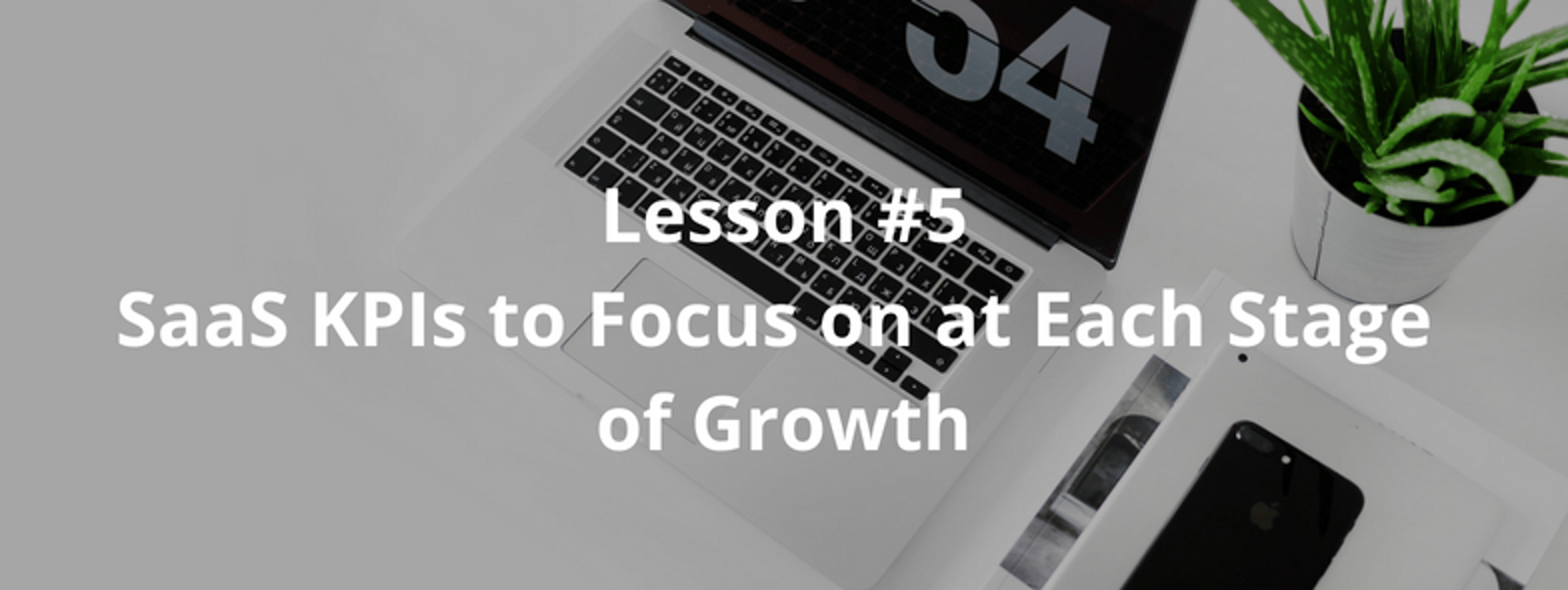
SaaS KPIs to Focus on at Each Stage of Growth
They may sound obvious, but these words from Paul Graham, the co-founder of Viaweb and Y Combinator, have grown into a truism for those working in the startup world:
“A startup is a company designed to grow fast.”
And if that startup is a SaaS company, Graham’s words could perhaps become “designed to grow really fast.”
As mentioned, it’s often this speed, and the resulting pressure, that leads to those working in the space to believe they need to always have a grasp on every SaaS KPI under the sun. The result, aside from being overwhelming and nearly impossible, is inefficiency. And inefficiency will ultimately limit growth.
Our CEO, Allan Wille, finds it helpful to organize SaaS KPIs in relation to where they are most important in these three stages of a SaaS company’s lifecycle: Product, Growth, and Efficiency.
Check out the infographic below to better align your KPIs with your SaaS company’s stage of development in order to maximize your efforts.
Product - Net Promoter Score
Net Promoter Score or NPS is a measure of a customer base’s willingness to promote a product or service to colleagues and friends. It is based on the results of a current customer survey, which asks respondents to answer the following question: (On a scale of 1-10) “How likely is it that you would recommend (brand or product X) to a friend or colleague?” (10 being ‘extremely likely’ and one being ‘not likely at all’)?
Responses are grouped as follows: 10s and 9s are brand ‘Promoters,’ 8s and 7s are ‘Neutrals,’ and any responses below 7 are brand ‘Detractors.’
NPS = proportion of Promoter scores - the proportion of Detractor scores
Growth - Brad Feld’s Rule of 40
The rule of 40% is simply a rule of thumb to analyze the health of a SaaS business. It takes into consideration two of the most important metrics for a subscription company: growth and profit (GP).
The formula is:
GP Ratio = Growth rate + Profit
This means your growth rate plus your profit should add up to 40%.
So in our formula above, that would be 40% = growth + profit.
Let’s take a look at some examples to identify our profit, assuming that we know our current growth rate.
- If you’re growing at 20%, you should be generating a profit of 20%. (40% - 20% = profit of 20%).
- If you’re growing at 40%, you could be generating a profit of 0%. (40% - 40% = profit of 0%).
- If you’re growing at 50%, you could even lose 10% of your profit. (40% - 50% = profit of -10%).
So if you’re doing 40%, you can consider that you have a healthy SaaS company - if you’re doing more than 40%, then that’s awesome - good for you!
In summary, when it comes to SaaS, the business usually works as a “winner-takes-all” situation, so sacrificing profit for growth isn’t always a bad thing.
Efficiency - CLV:CAC
The Customer Lifetime Value to Customer Acquisition Cost Ratio (CLV:CAC) measures the relationship between the lifetime value of a customer and the cost of acquiring that customer.
So how do you know if you’re spending the right amount? You need some numbers.
First, you need to know how long the average customer sticks with you before they cancel their service, that’s CLV. Because of course the longer a customer sticks with you, the more valuable they are.
Customer Lifetime Value (CLV) = Gross Margin % X ( 1 / Monthly Churn ) X Avg. Monthly Subscription Revenue per Customer
Once you have the lifetime value of a customer, you can turn your attention to calculating how much you spend acquiring a customer. Ideally, you want to recover the cost of acquiring a customer within the first 12 months or so.
Cost to Acquire a Customer (CAC) = Sales and Marketing Costs / New Customers Won
An ideal LTV:CAC ratio should be 3:1.The value of a customer should be three times more than the cost of acquiring them. If the ratio is close (i.e.1:1), you are spending too much. If it’s 5:1, you are spending too little. In fact, you are probably missing out on business!
Knowing these numbers allows you to understand what drives your business - the better the picture, the more levers you can pull to grow your business.
For more KPI inspiration, check out this list.
Speaking of growing SaaS companies ...
Online Reviews
Today, buyers are researching SaaS companies before ever contacting them in the form of online customer reviews. It's a whole new inbound lead strategy for marketers. In fact, 94% of customers read online reviews, and 92% of B2B buyers are more likely to purchase after reading a trusted review.
Online reviews also provide a channel for SaaS companies to show customers they care by providing a whole new customer service channel. On top of that, it allows for smaller SaaS platforms to level the competition on the playing field, legitimizing their solutions by putting them on the same pedestal.
Despite all of the knowledge we’ve shared with you, mistakes happen. Below we nail down the most common reasons KPIs fail and mistakes to avoid when determining your KPI strategy.
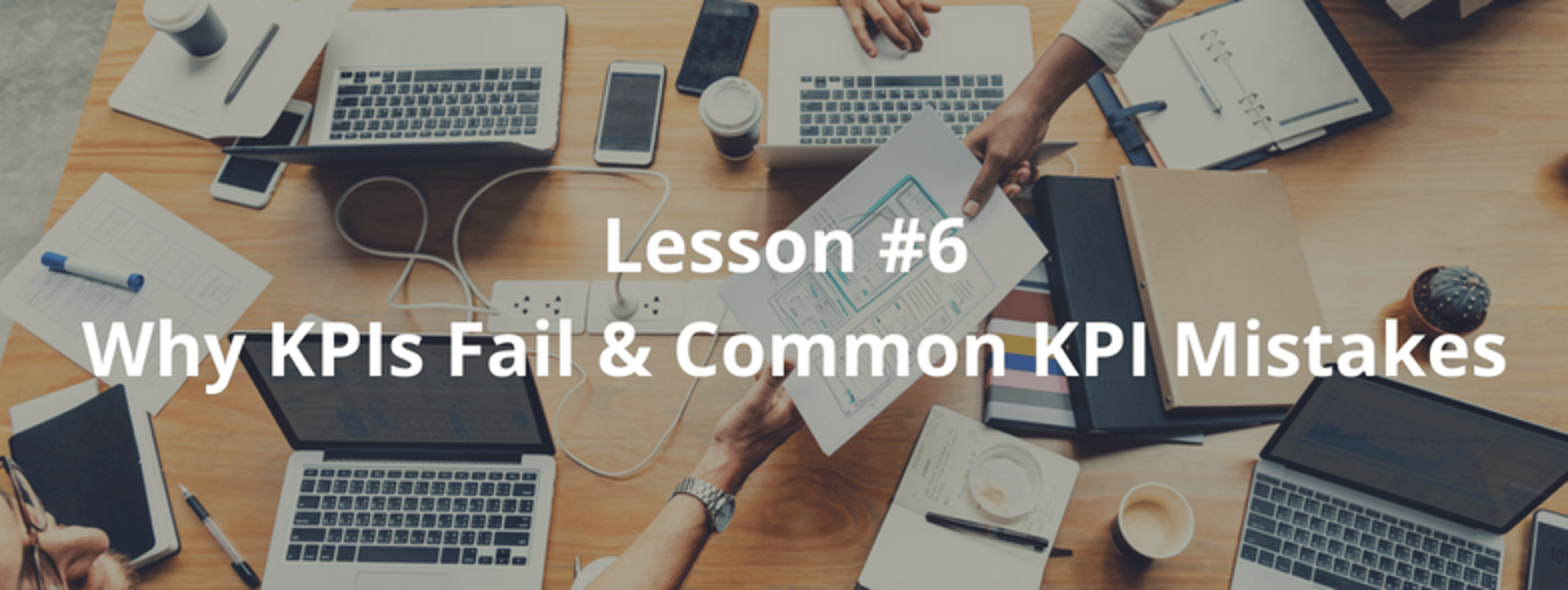
Why KPIs Fail + Common Mistakes
Okay, so at this point, you’ve sat in on what we consider a “KPI definition strategy” session. Your KPIs have been defined, you’ve got a rough outline of how to hit your targets, and your team is pretty clear on how to measure progress - that sounds like it ended on a high note! Easier said than done, we know.
But, when it comes to implementing a performance measurement strategy, the reality is often quite different than your lofty objectives.
KPIs, unfortunately, do fail.
Let’s take a look at five ways KPIs typically fail:
- Poorly defined
- Lack accountability
- Aren't achievable
- Lack specificity
- Too hard to measure
Poorly defined KPIs are doomed
A well-defined KPI is one that stands the test of time. Being SMART, as mentioned in Lesson 1, will help with this. The truth is that a well-defined KPI is structured and incorporates feedback from multiple areas of your business.
Cookie-cutter KPIs are a good starting point. But a KPI must address the unique challenges and opportunities of your business. Your unique KPIs should be a window into your current performance as it relates to your performance objectives.
KPIs often fail when they’re ill-defined. The most common pitfall at the definition stage is defining your organization's KPIs without outside feedback. A KPI should be recognizable and properly communicated outside of your business unit or department. And, of course, achieving your KPI target should have a clear and measurable impact on the business.
KPIs fail without accountability
You’ve defined a KPI that you know is going to move the needle for the business. Congrats! Now, who owns it?
Each KPI you define must have an owner, someone who is responsible for tracking and achieving the target associated with that KPI. It may sound strange, but KPIs require nurturing and nourishment. An isolated KPI will wither and die on the vine.
KPIs must have achievable targets
So you want to grow revenue to $50 million this year? Sounds great. But if your starting point is $5 million, you may be setting yourself up for a KPI fail.
A good way to set up targets for KPIs is to associate targets with a specific timeframe. This allows you to track progress on an ongoing basis and continually take corrective action.
KPIs without specific targets will fail
Let’s say you’re a runner, challenging yourself to run faster or longer than ever before. It’s a lot easier to achieve your goals if you set out specific milestones. There's a huge difference between saying you want to run a faster 5KM race and saying you want to run that same distance in 30 minutes.
Business outcomes benefit from the same degree of specificity. Rather than consistently challenging yourself to improve, give yourself a specific target, so you know when you’ve reached it and when you can start working towards the next.
The KPI is too hard to measure
The most common reason KPIs fail is that they can be hard to measure. KPIs blend data, business objectives, and departmental targets to act as guideposts for success. Without that first piece—data—your KPIs are abstract and conceptual.
Data is what grounds your KPIs, so you need to make sure you can actually measure and track your KPIs over time.
Set yourself up for success: avoid common mistakes
Even elite organizations struggle to avoid the most common KPI mistakes. They can occur at various points of a company’s development—including when new team leaders are hired, when new objectives are established, and/or when old KPIs are held onto even as an industry undergoes rapid change.
The most common KPI mistakes are:
- Reliance on intuition. This can arise from the overconfidence effect.
- Blindly adopting commonly-held best practices rather than creating your own.
- Bias toward the most recent information learned.
- Confusing lagging indicators (the easy-to-measure output) with leading indicators (the difficult-to-measure input).
Define and assign your KPIs, avoid these mistakes, and regularly assess your objectives. They are all likely to change as you gather new insights into the SaaS market and/or your product, which means assessments can and should be done both at the company and departmental levels.
Do all of this, and you’re golden! But yes, you aren’t expected to get this done in a week. Patience, diligence, and following up are key.
You’re nearing the end. Congrats on getting this far! The last topic is centered around how you can use dashboards to monitor your KPIs.

Monitor Your KPIs with Dashboards and Reports
So now what?
Now you know what a KPI is and the difference between metrics and measures. You know how to define your organization’s KPIs, and you know the best practices selecting the right KPIs and for avoiding the most common mistakes. You also know what the most important SaaS KPIs are. What now?
Once you have established benchmarks and targets for measuring KPIs, you’ll want to establish processes for monitoring them. Dashboarding can be critical in this regard. KPI tracking can be done using dashboard software, giving your entire organization insights into your current performance.
What is KPI software?
KPI software enables businesses to create, manage and analyze data from KPIs. The software allows organizations to enter their data into one specially designed system or connect external services for faster and more accurate data collection. This type of software allows businesses to visualize and comprehend data from a number of KPIs that represent different areas of a business, all in one place.
Companies benefit from KPI software through faster and more accurate data collection, instant reports on performance, and alerts when a KPI is over or underachieving. KPI software centralizes business data while simplifying real-time reporting to always give them a competitive edge. And because it's in the cloud and mobile, KPI software increases data visibility.
KPI Reports and Dashboards
To be useful, KPIs need to be monitored and reported on; if they change in real-time, they should be monitored in real-time. Dashboards are the perfect tool for your KPI reports as they can be used to visually depict the performance of an enterprise, a specific department, or a key business operation.
Have a look at some of our live dashboards for SaaS companies to demonstrate how you can present key performance indicators to your team:
- SaaS Executive Dashboard
- SaaS Growth Dashboard
- SaaS Metrics Dashboard
- SaaS Marketing Dashboard
- SaaS Support Dashboard
Looks like a ton of work to put those dashboards together, right? Not entirely. We’ve created pre-built dashboards and metric templates for some of the most popular services and data sources. In only a few minutes, you can use our Gallery to get the dashboards that matter the most to your business.
Imagine if you had a way to see all of your business metrics in one place – whenever you wanted to see them. You'd be able to check in and monitor the health of your business, spot problem areas, and optimize activities that are doing well.
We use our Klipfolio dashboards every day. With all of this data, we continuously make incremental improvements to all areas of our business.
Happy Dashboarding
So, what do you think? Want to see all of your business metrics and KPIs in one place, in real-time? With Klipfolio, you can.
Insert PDF Version of KPI Planner
KPI Planner
Put what you’ve learned to work and dive into constructing your own KPIs with our helpful and simple KPI Planner!
Enjoy!
Related Articles

Klipfolio Partner How-To #1: Duplicating dashboards across client accounts
By Stef Reid — November 27th, 2025
Klipfolio Partner How-To #2: Company Properties can simplify client set-up
By Stef Reid — November 26th, 2025
Top 10 Marketing Dashboard Ideas for Tech Companies
